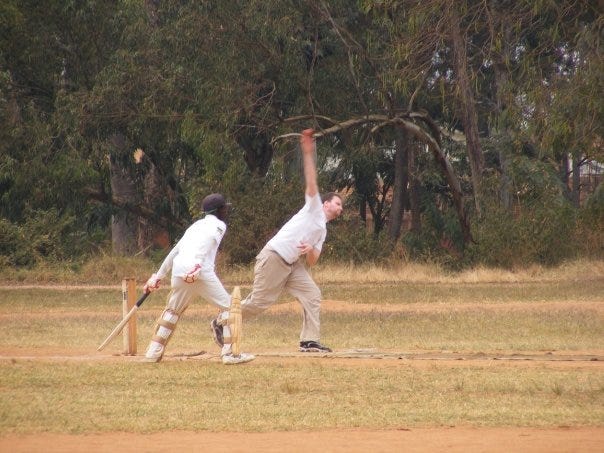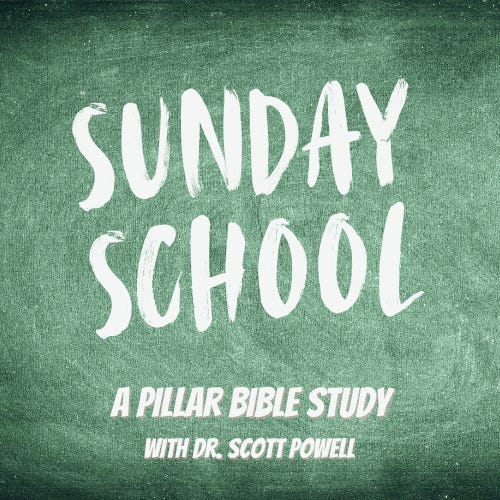Happy Friday friends,
And a happy feast of St. Kateri Tekakwitha. This newsletter comes to you in some haste this week.
I had arrived in Western Pa. at the family lake house for a few days of “working with a view” while our daughter got some much-needed socialization with her second cousins, but we’ve turned around in short order.
My grandmother has taken ill. She is nearly 90, so of course any illness is potentially serious, but even with that caveat, things seem very serious right now.
Of course, I hope and pray that she will recover. And I ask that if you can spare a moment you pray for that, too. But more than anything, I am praying that the Lord be with her in her illness, and that He will work his loving will for her.
She has had a full and beautiful life.
Her house for me, as a child, was a treasured place, where the kitchen always contained a baked cheesecake, the garden a full border of heaving raspberry canes, and the television a recorded-off-the-air copy of the original “Star Wars” — I can still tell you the moments in the film where it would break for commercials, and play in my mind the exact sequence of ‘80s beer and car ads, intercut with previews of that week’s episode of “Newhart.”
It was in her living room, sitting next to her husband, my grandfather, that I would watch Cubs games and the Bulls’ first championship runs.
In her later years, in addition to her own children and more than a dozen grandchildren, she has been the proud matriarch of 20 great-grandchildren, with more on the way — a mounting total admired with bewildered and naked envy by her friends and neighbors.
I remember well from my own wedding how the priest imparted the nuptial blessing and declared (with some strength of voice): “May you live to see your children’s children!”
For nearly 15 years, as my wife and I waited with waning hope for the arrival of our first child, I thought often and ruefully of that benediction.
I also remembered it with some emotion as I held our daughter, on the night she was born.
My grandmother has lived to see her children’s children’s children. What from the outside, and from a certain point of view, may strike many as a quiet suburban life of little note has, in fact, been of real and exponential consequence.
Seen through the eyes of heaven, hers has been a life well lived, much loved, and fruitful beyond reckoning. While I pray for her now, I pray also that the Lord may bless me with a life half as full.
The News
An interim policy memo from Alaska’s corrections department has banned the use or consumption of altar wine in prisons.
As it turns out, state and federal prison policies around altar wine for Catholics have been subject to numerous legal challenges in the last couple of decades. Many places allow priests to bring in the minimum amount needed for the consecration, and allow only the celebrant to receive under both kinds, but Alaska is going for a total ban.
This presents a number of canonical problems since it is absolutely forbidden for a priest to consecrate one Eucharistic species without the other, and while Catholics are only required to receive Communion once a year, depriving them of even the chance to attend Mass seems draconian.
There may be some options for chaplains to try, with the help of their bishops. Mustum, essentially fermented but non-alcoholic wine, is valid matter for the Eucharist, but it is intended as a substitute only for priests with a severe alcohol intolerance. Stably allowing it to be used in jail would need Roman approval.
You can read all about it here.
—
An Australian bishop was welcomed to his new diocese this week with a smoking ceremony led by a member of the country’s Aboriginal community. “A what?” you might very well ask.
Smoking ceremonies are actually a fairly stable feature at many big public events in Australia, including Catholic liturgies. We took a look at what went on in Toowoomba, and at other, similar kinds of liturgical enculturation which take place with Native peoples in America too.
And since it seemed like a good idea to get an expert’s opinion, we asked Archbishop Charles Chaput, only the second bishop in the U.S. to have Native heritage, about the whole idea.
—
Among Pope Francis’ list of new cardinals announced last Sunday was auxiliary Bishop Américo Aguiar of Lisbon — the man charged with delivering World Youth Day in that city next month.
Filipe also spoke to several clergy of the Lisbon patriarchate about the improbable and meteoric rise of Aguiar, a late vocation and former socialist politician, and how he might help shape the Church in Portugal and in Rome for decades to come.
This is an interview you will want to read.
—
Speaking of the newly announced cardinals-elect, a question we get asked a lot here at The Pillar is: When does one become a cardinal, exactly?
Can they vote in a conclave right away, and should we start calling them “Your Eminence” now? Or do we (and they) have to wait for the consistory in September?
—
You may have missed it, but the Vatican Secretary of State, Cardinal Pietro Parolin, has been on a peace mission this week. But unlike the Ukraine war initiative led by Cardinal Zuppi, it didn't generate many headlines.
Azerbaijanis and Armenians have been at loggerheads since the last years of the Cold War. It’s a deeply entrenched conflict, but one — as Luke argues — that could prove to be a shrewd investment of the Holy See’s diplomatic capital.
Editorial heresy
Working as I do in what my wife sarcastically refers to as “the Catholic media space,” I cannot completely avoid the volume of things written and spoken which appear deliberately couched to annoy me.
One thing which I found both impossible to ignore this week was an essay published in America Magazine, an outlet with which I frequently disagree, but which I often consider to be good reading.
In an article titled “The Eucharist is the body of Christ, not the body of Jesus. What we call it matters,” Msgr. Kevin Irwin offered his reflections on some “examples where citing the church’s magisterium precisely and where offering the Mass according to the ‘texts and rites’ of the Roman Missal are crucial,” because, he said, “sometimes phrases can be misquoted and possibly lead to heterodox ideas.”
I have to say this grabbed my attention, since the headline seemed to do exactly what the article ostensibly sought to condemn.
But Msgr. Irwin is a professor of theology at The Catholic University of America — an ecclesiastical faculty erected by the Holy See for the teaching of sacred sciences and held to particular standards by canon law — so I was interested to see how the essay played out.
“Taking liberties with the wording of magisterial teachings or the wording of the liturgy is an extremely dangerous and self-serving exercise in terms of the church’s belief,” Irwin wrote, and I could not possibly agree more.
He went on to specifically argue that referring to the Eucharistic presence as “the body of Jesus” is misleading and corruptive of the Church’s teaching, and that the correct formulation of “the body of Christ” is substantially different both in significance and doctrinal meaning.
“To describe the Eucharist as the ‘body of Jesus’ or ‘the real presence of Jesus’ would be too limiting to the historical body and earthly reality of the Word made flesh and the incarnate Son of God.
The ‘body of Christ’ refers to the entirety of the mystery of the totality of Christ: his whole earthly ministry and also his suffering, death, resurrection and ascension to the Father’s right hand to intercede for us in heaven. The Eucharist is the real presence of this body of Christ, not Jesus only.”
A couple of things struck me about the essay.
The first was that it was not clear to me — and Msgr. Irwin did not say — where exactly, this supposed epidemic of terminological abuse is meant to be taking place, though the article did offer these reflections in the “context” of the national Eucharistic revival and featured a prominent picture of its leader, Bishop Andrew Cozzens.
I cannot recall seeing the usage of “the body of Jesus” in that context.
I do admit to having seen enough liturgical novelty in this country to accept it might be happening somewhere. Though I’d have had a much better frame of reference for reading the article if it had said so plainly.
His argument, as best as I can make out, is that while it is acceptable to refer to the real presence of “Christ” in the Eucharist, and even of “Jesus Christ,” referring to the presence of “Jesus” somehow introduces a distinction, meaning the purely historically incarnate manifestation of the Second Person of the Trinity.
Now, my own postgraduate training in theology was some time ago, but several people better versed in such things than I have observed that an attempt to separate out the natures and titles of Christ into distinct persons, instead of holding them as essentially and inextricably united, seems like the textbook definition of the ancient heresy of Nestorianism.
I don’t want — indeed, I don’t think it would be fair — to accuse Msgr. Irwin of implicitly (or even explicitly) accepting and promoting a Nestorian premise, but the essay as published is certainly open to that interpretation.
Now, while he doesn’t state where this apparently problematic reference to the “body of Jesus” is happening, it could be that he is attempting to clarify and argue against exactly that sort of heterodoxy from happening elsewhere.
But the headline chosen by the editors certainly seems to fall into Nestorian error, though perhaps without understanding the issue. To their credit, they seem to have recognized that their handiwork struck many as committing the very heresy the article was apparently trying to warn against: as of this morning, it has been re-titled (albeit without an explanation for the change) “Language matters. The Eucharist is more than ‘the body of Jesus’.”
Language matters indeed.
It’s a cautionary tale for all of us in “the Catholic media space” when working with discussions of important and nuanced theological truths at the center of our faith.
Absent good editing and an eye for the reader’s perspective, even the most educated of arguments can come across as falling to meet the bar of a reasonably well-catechized eight-year-old.
What do they know of cricket?
Yesterday was the first day of play in “Major League Cricket,” a new tournament hoping to bring back the world’s second most popular sport in the good old U.S. of A.
I say “bring back” because, if you didn’t know already, cricket was widely popular in this country for many, many years, before being eclipsed by the invention of baseball. Indeed, the first-ever international game was played not between the sport’s creators, England, and the countries where it is most popular, Australia and India, but between America and Canada in 1844.
Having been raised in England and educated at the school where the first recorded cricket match was played, I have loved the game for years — indeed, in my 20s, I briefly captained a team and have been a member (part-owner/season ticket holder) of Surrey County Cricket Club since I was 19.
Back in 2008, I helped organize (and play) a game in Kigali between a team of U.K. diplomats and visiting politicians against the newly minted Rwandan national team, which was quite the experience.
The day before the game, I watched as the gopher-hole-riddled pitch was prepared by a man who poured several gallons of gasoline down the holes before dropping a match into one — the result was a series of mini volcanic eruptions spreading across the field, meant to exterminate the gophers, so the holes could be filled in without their being immediately reopened.
Cricket is, after baseball, my second great sporting love, and I have been absolutely spellbound by the current Ashes series (England vs. Australia) being played out on the other side of the Atlantic.
Given my well-known and violent opposition to the rule changes made to baseball in recent years, you might expect I’d be greeting the arrival of professional cricket to these shores with open arms, but I’m not. For a start, I have decidedly mixed feelings about the shorter form of the game being played, a kind of abridged version invented to ape baseball, as it happens.
And I just don’t see much room to grow for MLC; it strikes me as a misguided venture from the start.
I do, however, understand why they want to give it a try. While cricket is seen by most Americans as an impenetrable and absurd game, it has a fanatical and highly lucrative global following.
The 10-team, short-season Indian Premier League alone is worth billions — each team is valued at more than a billion dollars, and their value is growing at an average rate of 24% a year.
The reason I doubt Major League Cricket will find much of an audience is that the game — like baseball — is rooted deeply in the history and realities of community and culture.
For sure, there are sizable West Indian, Indian, Pakistani, Sri Lankan, and even Antipodean communities that will embrace the game’s American return. Perhaps these communities are enough to sustain the league, and maybe it can attract enough superannuated stars out of semi-retirement to gin up some overseas TV interest.
And maybe MLC’s ambitions go no further than that — but I doubt it. This seems to me, from what I’ve read, to be a grab for a new big market and exponential growth. On those terms, I cannot see it working.
Unlike football (or “soccer,” if you must) there is already an analog bat-and-ball sport deeply embedded in our national life, and I doubt there is room for another.
I can't see how you can replicate, or bypass, the generational and deeply enculturated nature of cricket enthusiasm in other places — which is, again like baseball, fostered primarily in schools, village green/sandlot games, and generational affinity.
The wealth of cricket literature underlines this. The best of books about cricket — both playing and cheering — are usually autobiographical and/or sociological studies of a community.
If you are looking for examples, I’d recommend the peerless “Beyond a Boundary” by C.L.R. James, Markus Bergman’s hysterically funny “Rain Men: The Madness of Cricket,” and “You Must Like Cricket? Memoirs of an Indian Cricket Fan” by Soumya Bhattacharya.
The fatal problem MLC will encounter, I suspect, is that the game needs to be part of your life and of life around you for you to truly love it — again like baseball.
“Soccer” is just 22 men kicking a ball; it’s intuitive and simple, you can explain it to a 1 year old. Cricket (and baseball) are complicated, engrossing, and at times arbitrary games rooted in tradition and steeped in history.
You need to have some contact with that tradition and history to appreciate the game.
MLC’s backers seem to have decided that if a sport is widely popular and lucrative somewhere, there’s no reason it cannot be so somewhere else, too. But this new league takes the game in isolation, and treats it as a marketable commodity and a replicable business model. In doing so they miss everything that makes it beautiful.
As C.L.R. James famously asked: “What do they know of cricket who only cricket know?”
Not enough to make the game pay, I’m betting.
See you next week,
Ed. Condon
Editor
The Pillar







